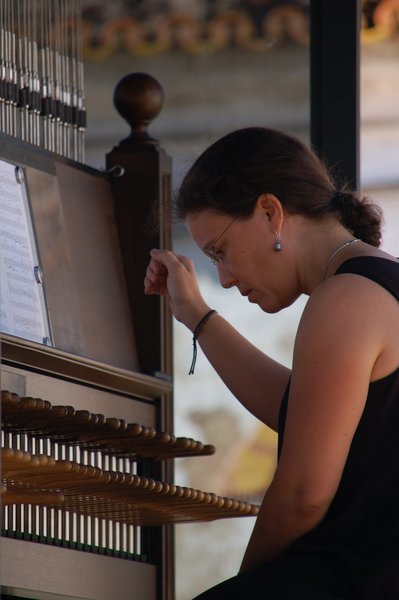1 de junho | June 1st
Festival Internacional de Carrilhão de Mafra 2025
1 de junho | 17h00 | Claustro Sul do Real Edifício de Mafra
Ana Elias (Portugal)
Programa | Program
Introdução
Prelúdio da Suite nº 1 para violoncelo
Johann Sebastian Bach (1685-1750) - arr.: Ana Elias
Pop-Rock
Heal the World
Michael Jackson (1958-2009) - arr.: Tiffany Ng
1492: Conquista do Paraíso
Vangelis (1943-2022) - arr.: Ana Elias & Eddy Mariën
The Addams Family Theme
Vic Mizzy (1916-2009) - arr.: Ana Elias
Hallelujah
Leonard Cohen (1934-2016) - arr.: Ana Elias
Original para Carrilhão
Cortege
John Courter (1941-2010)
Beacon Light Mast
David Cieri (n. 1974)
Balada para Lúcia
John Courter (n. 1962)
Música Portuguesa
Verdes são os campos
José Afonso (1929-1987) - arr.: Ana Elias
Hino dos Mineiros
Anónimo - arr.: Ana Elias
Porto Sentido
Rui Veloso (n. 1957) - arr.: Ana Elias
Amar Pelos Dois
Luísa Sobral (n. 1987) - arr.: Ana Elias
Verdes Anos
Carlos Paredes (1925-2004) - arr.: Ana Elias
Final
Bella Ciao
Tradicional italiano - arr.: Ana Elias
Ana Elias (Portugal)
Hoje uma conceituada carrilhanista, presidente e professora da CICO, Ana Elias, quando ainda era adolescente, ao subir à torre do Carrilhão de Mafra, ficou deslumbrada com o som celestial que se desprendia dos enormes sinos, inundando o espaço em redor de uma musicalidade para ela então ainda desconhecida. E foi aí que começou a sonhar tornar-se carrilhanista.
Nessa altura, andava no ensino secundário e, simultaneamente, estudava música no Instituto Gregoriano de Lisboa (IGL). Entretanto, ingressou no Instituto Superior Técnico (IST), com a ideia de se tornar Engenheira de Minas, mas, após ter terminado a sua formação musical no IGL, interrompeu o curso de Minas para prosseguir os seus estudos musicais na Escola Real de Carrilhão “Jef Denyn”, em Malines, na Bélgica, onde obteve o diploma de carrilhanista com Grande Distinção. Respirava, agora, apenas música, concluindo o Mestrado em Música, com agregação ao ensino no Lemmensinstituut, em Lovaina, também na Bélgica e, paralelamente, o curso de órgão, com Grande Distinção, no Conservatório de Mechelen. Mas, o bichinho da engenharia nunca a abandonou e, além deste percurso musical, terminou, também, o Mestrado em Engenharia Geológica e de Minas pelo IST.
O sonho concretizou-se e, enquanto carrilhanista, foi galardoada com vários prémios internacionais. Mas, não parou de sonhar e, ao querer reavivar esta arte em Portugal, desenvolveu com a irmã, Sara Elias, o projeto de um carrilhão itinerante, que foi vencedor do “Prémio Sagres-Expresso 2004”, que levou, juntamente com o pai Alberto Elias, à criação da CICO e à aquisição do Carrilhão LVSITANVS.
O carrilhão é a paixão de Ana Elias, contando na sua carreira inúmeros concertos por todo o mundo e um CD integrado na coleção “Porto 2001 – Capital Europeia da Cultura”. É, hoje, uma artista profissional e professora, apaixonada por interligar a sua experiência em música, engenharia e pedagogia, ao trabalhar em projetos relacionados com a arte do carrilhão. É, também, a diretora artística do FICOC – Festival Internacional do Carrilhão e do Órgão da CICO, que todos os anos reúne artistas nacionais e estrangeiros em Constância e arredores. Frequentemente, é vista a conduzir o maior carrilhão itinerante do mundo, o Carrilhão LVSITANVS, por Portugal (e, também, por Espanha), em direção a mais um concerto. A sua “copilota”, tanto em viagem como em todos os momentos da sua vida, tem apenas sete anos e já segue os passos da mãe.
Ana Elias's passion for the carillon was ignited in her adolescence when the celestial sound emanating from the bells of Mafra Tower captivated her, inspiring her to pursue a unique musical path. Today, she is an internationally renowned carillonneur, recognized for her mastery and her tireless commitment to reviving this art in Portugal. She also serves as president and professor at CICO, and is the artistic director of the prestigious FICOC - International Carillon and Organ Festival of CICO.
Her musical education began at the Gregorian Institute of Lisbon (IGL), but it was at the Royal Carillon School ‘Jef Denyn’ in Mechelen, Belgium, that Ana deepened her knowledge, earning her carillonneur diploma with Great Distinction. Her thirst for knowledge led her to complete a Master's in Music with teaching accreditation at Lemmensinstituut in Leuven, and, in parallel, to obtain an organ degree with Great Distinction from the Mechelen Conservatory. Interestingly, her "engineering bug" never left her, and she also holds a Master's in Geological and Mining Engineering from the Instituto Superior Técnico (IST), a background she now uniquely intertwines with her musical and pedagogical experience.
Throughout her remarkable career, Ana has been honoured with several international awards and has performed countless concerts worldwide, sharing the beauty of the carillon with audiences from different cultures. Her artistry is also perpetuated on a CD included in the “Porto 2001 - European Capital of Culture” collection.
Alongside her sister, Sara Elias, and her father, Alberto Elias, she is the co-founder of CICO. This visionary project spearheaded the creation of an itinerant carillon, which went on to win the Sagres-Expresso Award in 2004 and culminated in the acquisition of the imposing LVSITANVS Carillon. It is with this instrument, the largest itinerant carillon in the world, that Ana frequently travels across Portugal and Spain, bringing the magic of the carillon to new audiences and ensuring that this ancient art continues to resonate.
Above all, Ana is a professional artist and a dedicated teacher, whose vision and passion are the driving force behind the continuous appreciation and dissemination of the art of the carillon. Her "co-pilot," both on journeys and in all moments of her life, is her 7-year-old daughter, who is already following her mother's footsteps.

